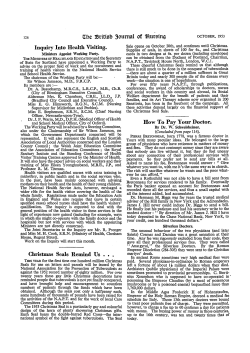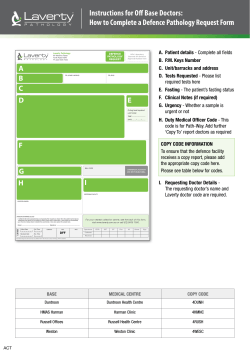
PGPPP Prevocational General Practice Placements Program Information for practices
PGPPP Prevocational General Practice Placements Program Information for practices What is it? The Prevocational General Practice Placements Program (PGPPP) is an Australian Federal Government initiative that provides hospital based junior doctors with an opportunity to experience a supervised General Practice placement as an accredited hospital rotation. Junior doctors (typically PGY2) undertake a 10-11 week rotation within an accredited GP training practice seeing patients under a staged supervision model. Like any other hospital rotation, it is an accredited hospital term and during the rotation the junior doctor remains an employee of the hospital. The program is administered nationally by General Practice Education & Training Ltd (GPET) and is delivered by Regional Training Providers (RTPs), such as GP Synergy. What are the supervision requirements? A GP Synergy accredited supervisor must be on-site 100% of the time the trainee is working. PGPPP doctors are required to move through four stages of supervision outlined by the organisation responsible for developing, conducting, coordinating, supporting and evaluating clinical education and training programs across the NSW public health system, Health Education and Training Institute (HETI). Some trainees may take longer to progress through different stages and some may never reach particular stages. Progression from one stage to another is dependent on the supervisor’s assessment and participation in the clinical supervision of the PGPPP Doctor; ensuring the PGPPP Doctor can practice safely at each stage, assessing the stage outcomes have been achieved and acknowledging achievement of the stage’s outcomes before the PGPPP Doctors moves to the next stage. The exception is progression of stages 3 to 4 which can only occur after the supervisor and a GP Synergy Medical Educator has formally assessed the PGPPP doctor. The four stages of supervision include:Stage 1: Observed Consultations: The PGPPP doctor sits in with the supervisor observing only for a minimum of one session. Stage 2 : Wave Consultations: This model of training involves the supervisor and the PGPPP doctor undertaking patient consultations consecutively. The supervisor reviews each of the PGPPP doctor’s patients while the patient is still present. Stage 3: Reviewed Consultations: During stage three, the PGPPP doctor sees patients independently with a review and discussion of all patients with the supervisor at the end of the session. Stage 4: Independent Consultations: The doctor is permitted to undertake an agreed range of “independent” consultations in an environment where the supervisor is “on call for the doctor, and will only review the management of a certain type or number of patient consultations. STAGE 1 Observed Consultations STAGE 2 Wave Consultations STAGE 3 Reviewed Consultations STAGE 4 Independent Consultations advancing medical training At the start of each Term GP Synergy runs a 2 day intensive orientation workshop for PGPPP participants to help prepare them for the Term. This covers topics such as contraception, common paediatrics, dermatology, professionalism, billing, prescribing and a review of some of the common consultations PGPPP Doctors may experience. PGPPP doctors are also invited to attend GP registrar workshops in negotiation with the practice. What teaching is required? PGPPP supervisors are required to provide a total of 6 (1 formal + 5 informal) hours of teaching time per week. This must include 1 hour of formal teaching which can encompass: • Formal tutorial • Case review • Demonstration of procedures • Formal in-house education presentations from visiting specialists/allied health. (Pharmaceutical Company Representatives excluded) • Other structured formal face to face activities negotiated with trainee and GP Synergy medical educator • Formal registrar teaching sessions if a practice has multiple trainees. Up to 5 hours of informal teaching can include: • Review of trainee’s consultations during supervision • Corridor consultation/advice • Demonstrating interesting pathology, etc. PGPPP supervisors are also required to release PGPPP doctors to participate in GP Synergy education activities: • GP Synergy PGPPP half day education workshop via videoconference (currently 2 per term). • 2 day orientation workshop at beginning of term • Half day “Wrap up” session at end of term. PGPPP supervisors are strongly encouraged to allow PGPPP doctors to participate in: • GP Synergy registrar day release educational workshops • Divisional educational activities • On-line activities available through • RACGP’s GP learning portal or ACRRM’s • RRMEO • Peer tutorials at feeder hospital. What are the funding arrangements? There is considerable funding available to support practices who train PGPPP doctors. In addition to this funding practices keep the Medicare billings the PGPPP doctor generates. This funding includes:• Infrastructure payment: $2000 per term • Supervision payment: $7800 per term (based on $125/hr x 6 hours per week x 10.4 weeks) • Total Funding: $9800.00 per term plus 100% Medicare Billings N.B. PGPPP doctor salaries for normal hours are covered by the program. What other support is available for practices? GP Synergy has a dedicated PGPPP Team who liaises with Hospitals, practices, supervisors and the PGPPP Doctors. This includes a PGPPP Manager and a PGPPP Program Officer to assist with practice accreditation, orientation, administration (applying for Medicare Provider numbers), evaluation and assistance during the Term. We also have a Medical Educator (ME) in the role of the Director of Prevocational Education and Training (DPET) on the PGPPP Team, who will be in contact the PGPPP participant and the supervisor throughout the term to discuss the PGPPP doctors progress and gather supervisors feedback. The DPET can also assist practices with setting up supervision and timetabling. GP Synergy also covers the cost of medical indemnity insurance for the trainees. Why is it important for junior doctors to have the opportunity to experience general practice in their hospital training? Many junior doctors have had limited exposure to general practice during their training and have an incomplete understanding of the primary care environment and what happens to patients after they leave the hospital. Improving a junior doctors understanding of the primary care and the way hospital doctors interact with primary care providers is critical for patient wellbeing. A PGPPP term allows the doctor to have hands on experience of general practice over and above what they may have experienced in medical school which extends their knowledge and understanding of the role of general practitioners. A PGPPP rotation also allows junior doctors that are unsure of their career plans to try general practice during their formative career decision making years. Exposure to the general practice profession is limited in most hospitals and often not well represented. PGPPP is one of the few ways junior doctors can be inspired to consider the profession as a future career choice. Which practices can participate in PGPPP? To be considered to participate in the PGPPP program, practices need to:• Review the HETI PGPPP Standards and GPET PGPPP Practice Guidelines • Meet the HETI PGPPP Standards • Nominate a Principle and Secondary accredited GP Supervisor • Have a dedicated consultation room available for 40hrs/week for the PGPPP Doctor • Participate in a practice site visit check • Provide an orientation/induction for the PGPPP Doctor • Participate in supervisor workshops (when required) Do I have to participate for all 5 terms in the year? How many terms are there in a year? There are 5 terms in a year, each term of 10 or 11 weeks duration. What are the term dates? Term 1 Term 2 Term 3 Term 4 Term 5 21 January 2013 8 April 2013 17 June 2013 26 August 2013 4 November 2013 7 April 2013 16 June 2013 25 August 2013 3 November 2013 19 January 2014 11 weeks 10 weeks 10 weeks 10 weeks 11 weeks Do I have to take a PGPPP every term? Practices are able to participate in the program for all 5 terms or participate for a specific number of terms in a year. Where do the junior doctors come from? PGPPP participants are junior doctors from training hospitals located within GP Synergy’s boundaries, as listed below. Network 1: RPAH Network 2: Bankstown and Campbelltown Network 3: Concord Network 4: Liverpool Network 5: RNSH Network 6: Hornsby Network 8: St George Network 9: POWH Network 10: St Vincent’s Network 12: Tamworth Will the PGPPP participant be eligible for a provider and prescriber number? The PGPPP participants will be PGY2 (or above) and are eligible for Medicare provider/prescriber numbers. For more information contact GP Synergy - see overleaf for details If you would like more information about becoming involved in the PGPPP program, please contact:- Dr Graham Lee Lexi Kyle Jani Mal Director Prevocational PGPPP Program Officer PGPPP Program Manager Education & Training P: 02 9756 5711 P: 02 9756 5711 P: 02 9756 5711 E: grahaml@gpsynergy.com.au E: janim@gpsynergy.com.au E: lexik@gpsynergy.com.au www.gpsynergy.com.au
© Copyright 2025











